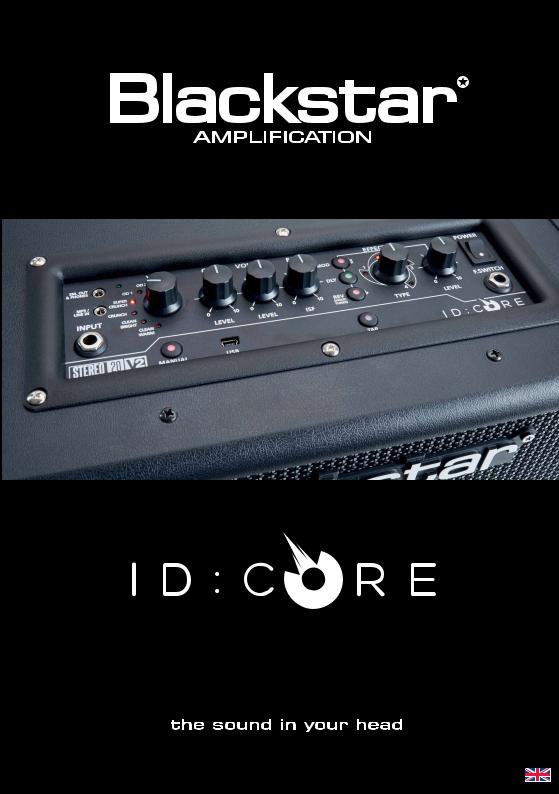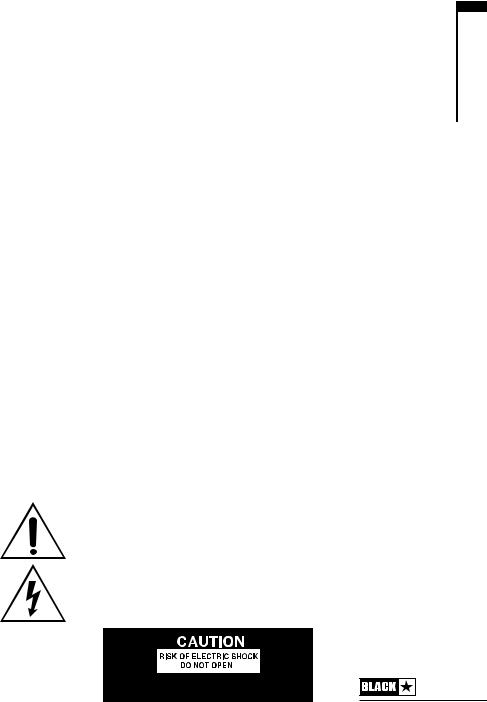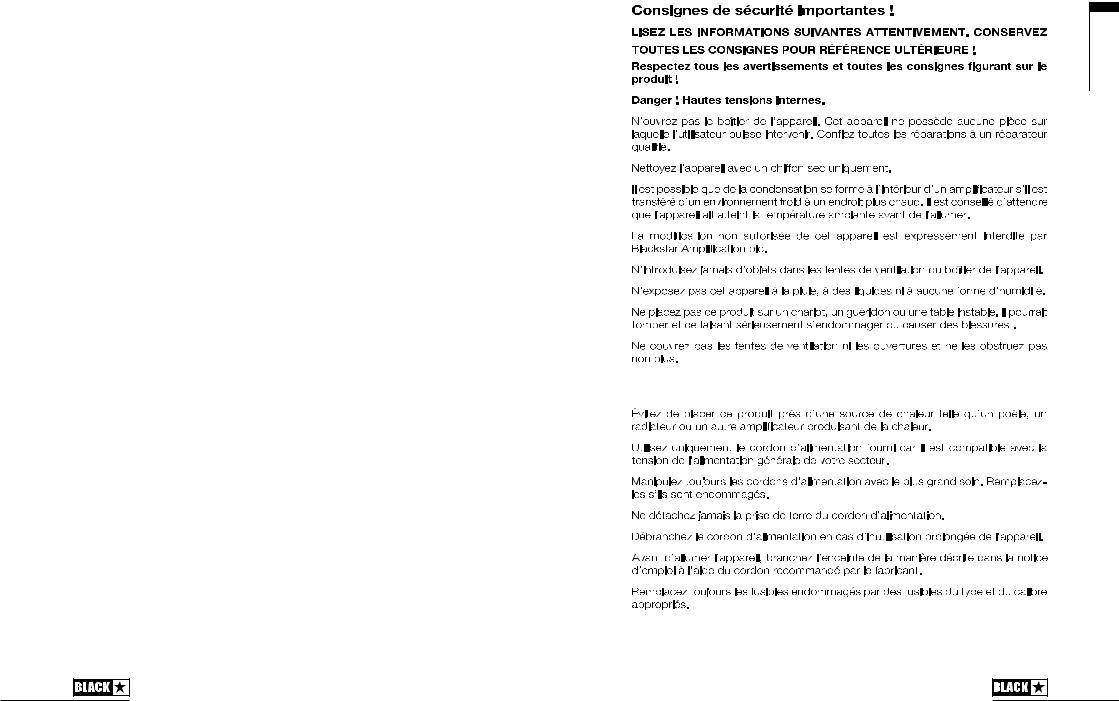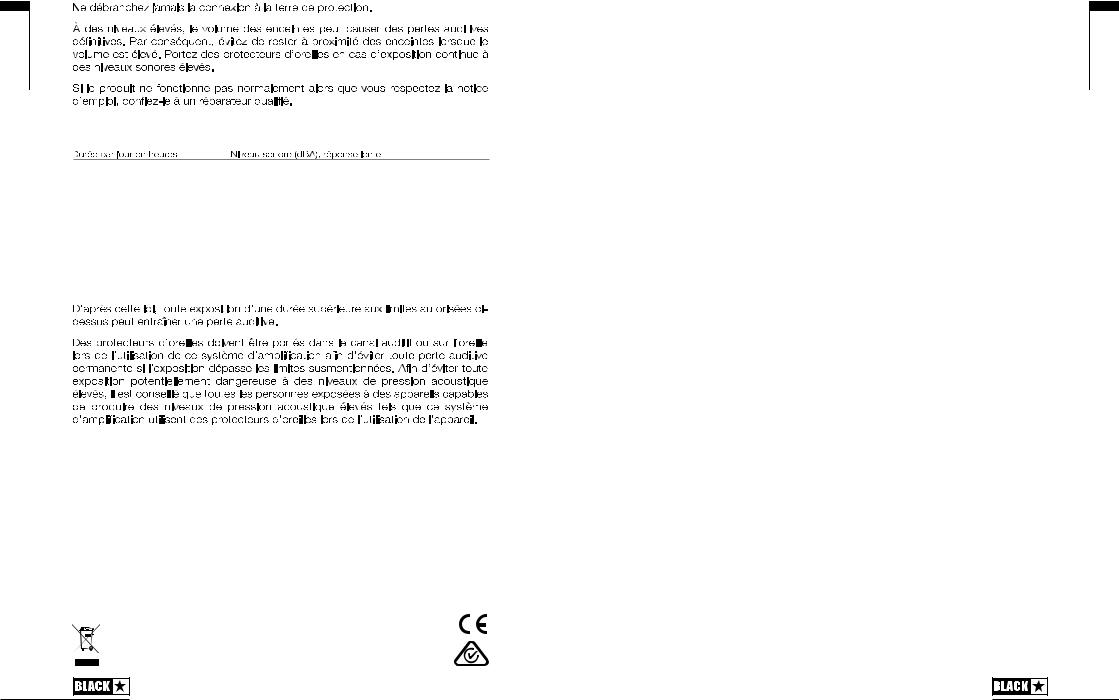Blackstar ID:CORE STEREO 10 V2, ID:CORE STEREO 20 V2, ID:CORE STEREO 40 V2 Users Manual

ID:CORE STEREO 10 V2, ID:CORE STEREO 20 V2,
ID:CORE STEREO 40 V2
Owner’s Manual
Designed and Engineered by Blackstar Ampli cation UK

IMPORTANT SAFETY INSTRUCTIONS
1.Read these instructions.
2.Keep these instructions.
3.Heed all warnings.
4.Follow all instructions.
5.Do not use this apparatus near water.
6.Clean only with dry cloth.
7.Do not block any ventilation openings.
8.Install in accordance with the manufacturer’s instructions.
9.Do not install near any heat sources such as radiators, heat registers, stoves, or other apparatus (including amplifiers) that produce heat.
10.Do not defeat the safety purpose of the polarized or grounding-type plug. A polarized plug has two blades with one wider than the other. A grounding type plug has two blades and a third grounding prong. The wide blade or the third prong are provided for your safety. If the provided plug does not fit into your outlet, consult an electrician for replacement of the obsolete outlet.
11.Protect the power cord from being walked on or pinched particularly at plugs, convenience receptacles, and the point where they exit from the apparatus.
12.Only use attachments/accessories specified by the manufacturer.
13.Unplug this apparatus during lightning storms or when unused for long periods of time.
14.Refer all servicing to qualified service personnel. Servicing is required when the apparatus has been damaged in any way, such as power-supply cord or plug is damaged, liquid has been spilled or objects have fallen into the apparatus, the apparatus has been exposed to rain or moisture, does not operate normally, or has been dropped.
“TO COMPLETELY DISCONNECT THIS APPARATUS FROM THE AC MAINS, DISCONNECT THE POWER-SUPPLY CORD PLUG FROM THE AC RECEPTACLE.”
“WARNING: TO REDUCE THE RISK OF FIRE OR ELECTRIC SHOCK, DO NOT EXPOSE THIS APPARATUS TO RAIN OR MOISTURE. THE APPARATUS SHALL NOT BE EXPOSED TO DRIPPING OR SPLASHING AND THAT OBJECTS FILLED WITH LIQUIDS, SUCH AS VASES, SHALL NOT BE PLACED ON APPARATUS.”
This symbol is intended to alert the user to the presence of important operation and maintenance (servicing) instructions in the literature accompanying the appliance.
This symbol is intended to alert the user to the presence of uninsulated “dangerous voltage” within the product’s enclosure that may be of sufficient magnitude to constitute a risk of electric shock to persons.
Canada / USA
3

English
Warning!
Important safety information!
READ THE FOLLOWING INFORMATION CAREFULLY. SAVE ALL INSTRUCTIONS FOR FUTURE REFERENCE!
Follow all warnings and instructions marked on the product! Danger! High internal operating voltages.
Do not open the equipment case. There are no user serviceable parts in this equipment. Refer all servicing to qualified service personnel.
Clean only with a dry cloth.
Condensation can form on the inside of an amplifier if it is moved from a cold environment to a warmer location. Before switching the unit on, it is recommended that the unit be allowed to reach room temperature.
Unauthorised modification of this equipment is expressly forbidden by Blackstar Amplification Ltd.
Never push objects of any kind into ventilation slots on the equipment casing. Do not expose this apparatus to rain, liquids or moisture of any type.
Avoid placing vessels filled with liquid on top of the amplifier.
Do not place this product on an unstable trolley, stand or table. The product may fall, causing serious damage to the product or to persons!
Do not cover or block ventilation slots or openings.
This product should not be placed near a source of heat such as a stove, radiator, or another heat producing amplifier.
Use only the supplied power cord which is compatible with the mains voltage supply in your area.
Power supply cords should always be handled carefully and should be replaced if damaged in any way.
Never break off the earth (ground) pin on the power supply cord.
The power supply cord should be unplugged when the unit is to be unused for long periods of time.
Before the unit is switched on, the loudspeaker should be connected as described in the handbook using the lead recommended by the manufacturer.
Always replace damaged fuses with the correct rating and type. Never disconnect the protective mains earth connection.
High loudspeaker levels can cause permanent hearing damage. You should therefore avoid the direct vicinity of loudspeakers operating at high levels. Wear hearing protection if continuously exposed to high levels.
If the product does not operate normally when the operating instructions are followed, then refer the product to a qualified service engineer.
The U.S. Government's Occupational Safety and Health Administration (OSHA) has specified the following permissible noise level exposures:
Duration Per Day In Hours |
Sound Level dBA, Slow Response |
8 |
90 |
6 |
92 |
4 |
95 |
3 |
97 |
2 |
100 |
1½ |
102 |
1 |
105 |
½ |
110 |
¼ or less |
115 |
According to OSHA, any exposure in excess of the above permissible limits could result in some hearing loss.
Ear plug protectors in the ear canals or over the ears must be worn when operating this amplification system in order to prevent a permanent hearing loss if exposure is in excess of the limits as set forth above. To ensure against potentially dangerous exposure to high sound pressure levels, it is recommended that all persons exposed to equipment capable of producing high sound pressure levels such as this amplification system be protected by hearing protectors while this unit is in operation.
All electrical and electronic products should be disposed of separately from the municipal waste stream via designated collection facilities appointed by the government or the local authorities.
English
4 |
|
|
|
|
|
5 |
|
|
|
|
|
|
|

English
Introduction
Thank you for purchasing this Blackstar ID:CORE amplifier. Like all our products, this amp is the result of countless hours of painstaking Research and Development by our world-class design team. Based in Northampton (UK), the Blackstar team are all experienced musicians themselves and the sole aim of the development process is to provide guitarists with products which are the ultimate tools for self-expression.
All Blackstar products are subjected to extensive laboratory and road testing to ensure that they are truly uncompromising in terms of reliability, quality and above all TONE.
ID:CORE represents a truly ground-breaking achievement, combining unique innovations, an intuitive, traditional control set and the versatility of programmability.
Please read through this handbook carefully to ensure you get the maximum benefit from your new Blackstar product.
If you like what you hear and want to find out more about the Blackstar range of products please visit our website at www.blackstaramps.com.
Thanks!
The Blackstar Team
Features
Since 2007, Blackstar has led the way in the innovation of guitar amplification. ID:CORE represents the culmination years of technical Research and Development.
These amps have an intuitive control set like a traditional amp, but have the versatility of programmability. The unique controls allow you, the guitarist, to custom design your own sound.
The Voice control has six different settings – Clean Warm, Clean Bright, Crunch, Super Crunch, OD 1, OD 2. When used together with Blackstar’s patented ISF control you can get the exact tone you’re thinking of.
The effects section delivers studio quality Super Wide Stereo modulation, delay and reverb effects simultaneously that you can store with your sound. New for ‘V2’ products is the addition of a new envelope filter modulation effect for funky cleans, or touch-sensitive lead lines.
Deep editing and storing of patches is simple using the Blackstar INSIDER software.
Patches can be shared, uploaded and downloaded via the online community. The
USB connector also allows you to record from your amp directly to your computer, now with 4-channel USB audio flexibility and simpler Reamping for ‘V2’.
Blackstar has partnered-up with PreSonus to offer a free version of the awardwinning PreSonus Studio One recording software. Studio One Prime Blackstar
Edition is simple to use and intuitive - even for recording novices - whilst being immensely powerful and suitable for experienced recording professionals. For information on how to redeem your free copy for PC or Mac see the promotional card included with your new ID:CORE amplifier. For more information on Studio One visit http://www.presonus.com/products/Studio-One
An emulated stereo output, and stereo MP3/line input with Dynamic EQ for strong bass response at low volumes, complete the package.
English
6 |
|
|
|
|
|
7 |
|
|
|
|
|
|
|

English
Factory Reset
The default factory patches and settings can be restored to your amplifier at any time. Simply hold down the MOD, DLY and REV switches simultaneously, whilst switching on the amplifier.
The voice LED will count down to indicate that a factory reset is imminent. If any of the MOD, DLY and REV switches are released before the Voice LEDs have switched off, then the operation is cancelled and the amplifier will remain unaffected.
Finally, switch the amplifier power off to complete the process. When powered on, your amplifier will be restored to the factory default settings.
IMPORTANT NOTE:
This process will overwrite any user saved patches and settings.
By using the unique Voice control and the patented ISF, ID:CORE amplifiers allow unparalleled flexibility and ease of use, enabling you to design the sound in your head and deliver it at home, in the studio or in rehearsal.
Front Panel
1. Input
Plug your guitar in here.
Always use a good quality screened guitar lead.
2. Voice
The Voice control changes the preamp voicing, ranging from ultra clean to extremely overdriven.
Clean Warm – Classic clean, dynamic
Clean Bright – ‘Boutique’, will break up when pushed hard
Crunch – Classic medium gain overdrive
Super Crunch – More gain and punch than Crunch
OD 1 – Hot-rodded Master Volume overdrive
OD 2 – Mid boosted overdrive
This setting is saved when you store a patch.
3. Gain
The Gain control adjusts the amount of overdrive or distortion. Low settings (counter clockwise) will deliver a clean sound on the edge of break-up. As the Gain control is turned clockwise the sound will become more overdriven, moving through beautiful crunch tones until, at its maximum position, a full distorted tone is achieved. This setting is saved when you store a patch.
4. Volume
This controls the preamp volume. High levels of volume will introduce the effect of valve power amp distortion and compression. This is a global setting and not saved when storing a patch.
USA |
|
UK |
5. ISF |
|
|
The patented ISF control allows you to choose the exact tonal signature you prefer. Fully counter clockwise has
a more American characteristic with a tight bottom-end
and more aggressive middle, and fully clockwise has a British characteristic which is more ‘woody’ and less aggressive. This leads to a very familiar, musical response. This setting is saved when you store a patch.
6. MOD (Modulation)
Press this switch to turn the stereo modulation effect on, off, or focus the effect for editing. This setting is saved when you store a patch.
7. DLY (Delay)
Press this switch to turn the stereo delay effect on, off, or focus the effect for editing.
English
8 |
|
|
|
|
|
9 |
|
|
|
|
|
|
|

English
This setting is saved when you store a patch.
8. REV (Reverb)
Press this switch to turn the stereo reverb effect on, off, or focus the effect for editing. This setting is saved when you store a patch.
For all three effect switches/buttons, the LED shows what state the effect is in:
LED |
Effect State |
Description |
LED not on |
Effect off |
Effect not active |
|
|
|
LED red |
Effect on but not ‘focused’ for editing |
Effect is active, but not affected by the front |
|
|
panel effect controls |
|
|
|
LED green |
Effect on and ‘focused’ for editing |
Effect active and affected by the front panel |
|
|
effect controls |
Repeatedly pressing each effect switches on the front panel has the following effect:
Current Effect State |
Next Effect State |
|
|
Effect off |
Turns the effect on and ‘focuses’ the effect. Any previously focused effect |
|
reverts to an ‘on’ state |
|
|
Effect on but not ‘focused’ |
Focuses the effect. Any previously focused effect reverts to an ‘on’ state |
|
|
Effect on and ‘focused’ |
Turns the effect off. If any other effect(s) are on, the previously ‘focused’ effect |
|
resumes being ‘focused’ |
NOTE: Only one effect may be ‘focused’ at any time.
9. Effect Type
This changes the effect type and edits a parameter of the currently ‘focused’ effect
(modulation, delay, or reverb).
Each segment represents a different effect (four for each type of effect). An LED shows which effect type is currently active. The distance travelled through the ‘segment’ modifies an effect parameter. The Effects Table below shows the modifiable parameters.
This setting is saved when you store a patch.
10. Effect Level
This modifies an effect parameter. For modulation and delay effects, turning the Level control while holding down the Tap button (11) modifies the rate/time of the effect.
The Effects Table below shows the modifiable parameters. This setting is saved when you store a patch.
11. Tap
The Tap switch is used to set the rate/time of the current ‘focused’ effect. The time between each press of the tap button defines the rate set.
Once set, the Tap LED will flash in time with the set rate of the currently ‘focused’ effect.
The Effects Table below shows the modifiable parameters:
Effects Table
Effect |
Segment Parameter |
Level Parameter |
Tap Parameter |
|
|
|
|
MODULATION |
|
|
|
Phaser |
Mix |
Depth |
Speed |
|
|
|
|
Chorus / Flanger |
Morph |
Mix |
Speed |
|
|
|
|
Envelope |
Sensitivity |
Depth |
- |
|
|
|
|
Tremolo |
Frequency modulation depth |
Amplitude modulation depth |
Speed |
|
|
|
|
DELAY |
|
|
|
Linear |
Feedback |
Delay level |
Time |
|
|
|
|
Analogue |
Feedback |
Delay level |
Time |
|
|
|
|
Tape |
Feedback |
Delay level |
Time |
|
|
|
|
Multi |
Feedback |
Delay level |
Time |
|
|
|
|
REVERB |
|
|
|
Room |
Size |
Reverb level |
- |
|
|
|
|
Hall |
Size |
Reverb level |
- |
|
|
|
|
Spring |
Size |
Reverb level |
- |
|
|
|
|
Plate |
Size |
Reverb level |
- |
This setting is saved when you store a patch.
12. Power Switch
This switch is used to turn the amplifier on and off; the white dot marks the ON position.
13. USB
Plug a USB cable in here to connect the amplifier to a Windows PC or Mac. Blackstar’s INSIDER software offers a host of features and can be downloaded from: www.blackstarinsider.co.uk
See the USB Audio section on page 15 for more information.
NOTE: The amplifier will appear on a personal computer as an audio capture device within recording software.
English
10 |
|
|
|
|
|
11 |
|
|
|
|
|
|
|

English
14. Manual
Press this switch to toggle between Patch and Manual Mode. When the amplifier is in Manual Mode, the sound will reflect the current physical position of the knobs.
This is applicable to the Voice, Gain, Volume and ISF knobs. Any effects that are active when switching to Manual Mode will be turned off.
While in Manual Mode any of the controls can still be modified by the Blackstar INSIDER software but this means that the sound will not represent the positions of the knobs on the front panel
Patch Mode
Patch mode is indicated by the Manual LED (14) being unlit. See Programmability section on page 14 for more information.
Tuner Mode
Holding Reverb (8) switch for one second will engage the tuner. The Recall Indicator LED (18) will flash continuously to indicate the amplifier is in Tuner Mode. The amplifier output will be muted whilst in Tuner Mode.
The Voice LEDs will indicate the closest note to the note being played.
Clean Warm |
String 1 (E) |
|
|
|
|
Clean Bright |
String 2 |
(A) |
|
|
|
Crunch |
String 3 |
(D) |
|
|
|
Super Crunch |
String 4 |
(G) |
|
|
|
OD 1 |
String 5 |
(B) |
The MOD, DLY and REV LEDs act as indicators to show how close the played note is to the tuned note.
MOD LED red |
Note is sharp (above pitch) |
|
|
DLY LED green |
Note is in tune |
|
|
REV LED red |
Note is flat (below pitch) |
All other LEDs on the front panel will be off in Tuner Mode.
Pressing any button will exit Tuner Mode.
15. Footcontroller (ID:CORE STEREO 20, 40 only)
Connect a Blackstar FS-11 footcontroller (not supplied) to control your ID:CORE in one of the following modes:
FS-11 |
Switch 1 |
Switch 2 |
Default Mode |
Toggles between 2 patches, |
Toggles all saved patch effects |
|
selectable via INSIDER |
on/off |
|
|
|
Alternative Mode |
Patch down |
Patch up |
In Alternative Mode (selected via INSIDER) patches will cycle on a ʻloopʼ. e.g switching up from OD2 will move to Clean Warm.
When in Manual Mode, the effect of any footcontroller switch will depend on its last state. Pressing Switch 1 will return the amplifier to Patch Mode. Pressing Switch 2 will toggle the effects off and on without returning to Patch Mode.
16. MP3/Line In
Connect the output of your MP3 or CD player here. Adjust the player’s volume to match that of your guitar to enable you to play along.
17. Emulated/Headphone Out
This output emulates the tonal characteristics of a guitar speaker cabinet and provides a natural tone for connection to headphones, a recording device, PA system or mixing desk.
To make full use of the Super Wide Stereo effects, use a ‘stereo 3.5mm jack to two mono jacks’ splitter lead to feed two channels of the recording device or mixer. Always use a good quality screened lead.
Turning the Volume knob will control the Emulated Output level.
NOTE: The Amplifer speakers will mute when a cable is connected to the Emulated Output.
English
12 |
|
|
|
|
|
13 |
|
|
|
|
|
|
|

English
18. Recall Indicator
The Recall Indicator shows if there is a mismatch between the current value of a parameter within the amplifier and the corresponding physical front panel control. For example, when you change to a different patch the controls on the front panel may not always reflect the setting you are hearing.
To prevent unexpected level jumps in the control you are adjusting, the front panel knobs will have no effect on the sound until the knob reaches the current parameter value. Once reached the Recall Indicator flashes twice and the knob ‘takes control’ of the value and can increase or decrease the value.
The recall indicator will flash each time the physical knob ‘passes through’ the currently active value that you are hearing.
Recall is active for Gain, Volume and ISF.
When the Tuner is active the Recall Indicator will flash continuously.
Rear Panel
1. DC Input
The supplied detachable DC power supply is connected here. Always ensure the
Power Switch (12) is in the OFF position before connecting the power supply. The lead should only be connected to a power outlet that is compatible with the voltage, power and frequency requirements stated on the power supply. If in doubt seek
advice from a qualified technician.
Programmability
Storing Patches
Your ID:CORE amplifier stores 6 patches (1 patch per Voice setting).
To store the current sound as a patch press and hold the Manual switch for two seconds. The currently selected Voice LED will flash to indicate the patch has been stored.
Storing a patch will overwrite any previous patch in that location. Patches can also be stored via Blackstar’s INSIDER software.
NOTE: Each patch on your ID:CORE must use the Voice setting assigned to that patch i.e. the Clean Warm patch uses the Clean Warm voice.
Recalling Patches
When in Patch Mode turn the Voice control to choose the desired Voice patch.
Patches can also be recalled via the Blackstar INSIDER software or a connected footcontroller (ID:CORE STEREO 20, 40 only).
NOTE:To recall a patch, the Manual LED must be off to indicate Patch Mode. Turning the Voice control while the Manual LED is on (in Manual Mode) will only select the indicated voice.
USB Audio
Standard audio drivers are used to connect the amplifier to a PC or Mac. No specific drivers are required. For a guide on low-latency USB recording visit: www.blackstaramps.com/usbrecording
NOTE: Always connect the amplifier via a main USB port, often found on the rear of the computer.
The amplifier will appear as an audio capture device within recording software.
The USB audio signal output level from your ID:CORE amplifier can be controlled independently of your amplifier’s speaker volume by holding down the Tap switch
(11) whilst turning the Gain control (3) on the front panel (see the Advanced Features section on page 16). This will allow you to achieve a strong recording signal level whilst monitoring the output at a lower, more comfortable level, or even silently if you prefer; simply turn the amplifier speaker volume to zero using the Volume control on the front panel.
The audio output via USB from your amplifier directly to your computer is carried across four independent, simultaneous channels:
Channel 1: Stereo emulated, left channel – The fully processed guitar sound, with speaker cabinet emulation. Contains the left channel of the Super Wide Stereo effects.
Channel 2: Stereo emulated, right channel - The fully processed guitar sound, with speaker cabinet emulation. Contains the right channel of the Super Wide Stereo effects.
Channel 3: Preamp output – The preamp sound of the Voice and EQ stage, taken before the effects, and without any speaker cabinet emulation. Ideal for use with your own effects and cabinet emulation plugins from your recording software/DAW.
Channel 4: Unprocessed guitar signal – The signal as it comes out of your guitar.
Record this signal for later use during Reamping (see ‘Reamping’ section below).
These audio streams can be recorded simultaneously within your chosen recording software/DAW.
TIP: To record a truly Super Wide Stereo-effected sound – which is faithfully recreated when playing back your recorded tracks on any stereo speakers – pan the stereo emulated left channel 100% left in the mix, and pan the right channel 100% right.
Your ID:CORE amplifier can also receive audio input from your computer:
Channel 1: Line input, left channel – Used for audio monitoring or MP3/backing track playback. Playback through the left internal speaker.
Channel 2: Line input, right channel – Used for audio monitoring or MP3/backing track playback. Playback through the right internal speaker.
Channel 3: Reamping input – Send a pre-recorded unprocessed guitar signal to your amplifier for Reamping, when in Reamping mode.
Channel 4: Unused
English
14 |
|
|
|
|
|
15 |
|
|
|
|
|
|
|

English
Reamping
The amplifier can be switched into Reamping Mode via the Blackstar INSIDER software. This is a non-storable setting and will be switched off either when the
USB cable is removed, or when the amplifier power is switched off.
When activated, Reamping Mode allows the amplifier to accept a pre-recorded, dry guitar signal via USB and return a fully processed audio signal. This return signal can
then be captured using recording software on the connected PC or Mac.
Advanced Features
Your ID:CORE amplifier has further advanced features which are aimed at more in-depth users who enjoy getting the most from their amplifier. These features do not have independent controls on the front panel of the amplifier, but instead are accessed by using the Tap switch (11) as a ‘shift key’ and using other controls to access these features.
Independent Music Playback Volume – Tap + Volume
Under most circumstances, the volume of your music playback via the MP3/
Line Input is effectively controlled directly from your playback device. For quieter environments and general convenience you can also further reduce the music playback volume of your ID:CORE amplifier by simply holding down the Tap switch (11) whilst turning the Volume control (4) on the front panel.
USB Recording Level – Tap + Gain
As stated in the USB Audio section (see page 15), the output level of the USB audio signal from your ID:CORE amplifier can be controlled independently of your amplifier’s speaker volume by holding down the Tap switch (11) whilst turning the Gain control (3) on the front panel.
Effect Speed/Time – Tap + Effects Level
As stated in the Effect Level section (see page 10), the speed/time of the modulation and delay effects can be controlled by holding down the Tap switch (11) whilst turning the Effect Level control (10) on the front panel. This can be very useful for setting a specific accurate effect tempo instead of using the Tap switch.
Firmware Update
Firmware updates are initiated via the Blackstar INSIDER software. A new version of the Blackstar INSIDER software will be released whenever an update is available.
Important note: Always connect the amplifier to a main USB port (usually found on the on the rear of your PC or Mac) when updating the firmware. Never use a front mounted USB port, USB hub or a USB extension cable. Doing so may result in a failed update, which could cause your amplifier to become unresponsive.
When the amplifier is connected (via USB) to a version of the Blackstar INSIDER software containing newer firmware, a message will be displayed prompting you to install the latest files. Whilst updating, the amplifier controls will be unresponsive.
Front panel voice LEDs will cycle to indicate data activity during the update process.
The amplifier power should not be switched off during a firmware update. If the amplifier is switched off during an update, the controls may be unresponsive after the power is reapplied and the amplifier will produce no sound. The voice LEDs will cycle to indicate that the amplifier contains no valid firmware.
If you are experiencing problems with the firmware update process the amplifier can be forced to power up in Update Mode. Hold down the Manual (14) & MOD (6) switches simultaneously, whilst switching on the amplifer to enter this mode with the voice LEDs cycling to indicate Update Mode. Connect the amplifier to the Blackstar INSIDER software to begin a firmware updae.
The amplifier must be connected to the Blackstar INSIDER software to reinstall valid firmware. The update process will start automatically if the Blackstar INSIDER software detects that the amplifier is in this state.
16 |
|
|
|
|
|
17 |
|
|
|
|
|
|
|

Technical Specification
ID:CORE STEREO 10 V2
Power: 2 x 5 Watts (Stereo 10 Watts)
Weight (kg): 3.7
Dimensions (mm): 340(W) x 265(H) x 185(D)
ID:CORE STEREO 20 V2
Power: 2 x 10 Watts (Stereo 20 Watts)
Weight (kg): 5.2
Dimensions (mm): 375(W) x 292(H) x 185(D)
Footcontroller (not supplied): FS-11 footcontroller
ID:CORE STEREO 40 V2 Power: 2 x 20 (Stereo 40 Watts)
Weight (kg): 6.2
Dimensions (mm): 434(W) x 336(H) x 185(D)
Footcontroller (not supplied): FS-11 footcontroller
18
Français
Cet appareil doit être utilisé dans un environnement bien ventilé et ne doit jamais être mis sous tension si l'endroit est confiné.
19

Français
La loi américaine sur la santé et la sécurité du travail indique la durée d'exposition autorisée à différents niveaux sonores:
8 |
90 |
6 |
92 |
4 |
95 |
3 |
97 |
2 |
100 |
1½ |
102 |
1 |
105 |
½ |
110 |
¼ or less |
115 |
Tous les produits électriques et électroniques doivent être jetés séparément, dans le flux de déchets municipaux, dans les lieux de collecte désignés par le gouvernement ou les autorités locales.
20
Introduction
Merci d’avoir acheté cet amplificateur Blackstar ID:Core. Comme tous nos |
Français |
produits, cet amplificateur est le résultat d’innombrables heures de recherche et |
|
développement minutieux par notre équipe de conception de classe mondiale. |
|
Basée à Northampton (Royaume-Uni), l’équipe Blackstar est composée de |
|
musiciens chevronnés et l’unique objectif du processus de développement est de |
|
fournir aux guitaristes les outils ultimes pour s’exprimer. |
|
Tous les produits Blackstar sont soumis à des tests intensifs en laboratoire et en |
|
conditions réelles pour s’affranchir véritablement de tout compromis en termes de |
|
fiabilité, de qualité et avant tout de SON. |
|
La série ID:CORE est véritablement révolutionnaire, combinant des innovations |
|
uniques, un jeu de commandes intuitives et traditionnelles, et la souplesse de |
|
programmation. |
|
Veuillez lire attentivement la totalité de ce mode d’emploi pour tirer le bénéfice |
|
maximal de votre nouveau produit Blackstar. |
|
Si vous aimez ce que vous entendez et voulez en découvrir plus sur la gamme de |
|
produits Blackstar, veuillez visiter notre site web à l’adresse www.blackstaramps. |
|
com. |
|
Merci ! |
|
L’équipe Blackstar |
|
21

Français
Caractéristiques
Depuis son lancement en 2007, Blackstar a ouvert la voie à l'innovation dans l'amplification guitare. ID:Core représente l‘aboutissement d’années de recherches et de développement. Ces amplis possèdent un contrôle intuitif comme un ampli traditionnel, mais avec la polyvalence de programmabilité en plus. Les contrôles uniques vous permettent, le guitariste, de concevoir sur mesure votre propre son.
La commande Voice a six réglages différents – Clean Warm, Clean Bright, Crunch, Super Crunch, OD 1, OD 2. Quand on les utilise avec la commande ISF brevetée de Blackstar, vous pouvez obtenir exactement le son auquel vous pensiez.
La section d’effets offre simultanément des effets de qualité studio comme la modulation Super Wide Stereo, le delay et la reverb, que vous pouvez mémoriser.
Nouveauté pour les V2, la présence d’une nouvelle modulation, envelope filter, pour des cleans funky, ou des parties lead qui répondent au touché.
L’édition en profondeur et la mémorisation des patches est simple grâce au logiciel Insider de Blackstar. Les patches peuvent être partagés, mis à disposition et téléchargés grâce à la communauté en ligne. Le connecteur USB vous permet aussi d’enregistrer directement de votre ampli vers votre ordinateur, avec la flexibilité de l’interface audio USB 4 canaux et la fonction de ré-amplification simplifiée avec les V2.
Blackstar s’est associé avec Presonus pour offrir une version gratuite du logiciel d’enregistrement primé, Presonus Studio One. Studio One Prime Blackstar Edition est simple d’utilisation et intuitif – même pour les débutants en enregistrement – tout en étant incroyablement puissant et parfait pour les professionnels expérimentés. Pour savoir comment obtenir votre exemplaire gratuit pour PC ou mac, consultez la carte d’information inclue dans votre nouvel amplificateur ID:CORE. Pour plus d’information sur Studio One, allez sur : http://www.presonus.com/products/ Studio-One
La sortie simulateur de HP et l'entrée MP3/ligne avec un égaliseur dynamique pour des basses fortes même à bas volume, complètent l’ensemble.
Réinitialisation d’usine
Les patches et réglages d’origine par défaut peuvent être à tout moment restaurés dans votre amplificateur. Maintenez simplement pressés simultanément les boutons MOD, DLY et REV, pendant que vous allumez l’amplificateur.
Les LEDs de la commande Voice s’éteindront successivement pour indiquer l’imminence de la réinitialisation d’usine. Si n’importe lequel des boutons MOD, DLY ou REV est relâché avant que les LEDs Voice ne se soient toutes éteintes, alors l’opération est annulée et l’amplificateur ne subit aucune modification.
Eteignez l’amplificateur pour compléter le processus. Quand vous le rallumerez, les paramètres d’usine de votre amplificateur seront restaurés.
NOTE IMPORTANTE:
Ce processus écrasera tout contenu créé par l’utilisateur.
Avec l'exceptionnelle commande Voice et l’ISF brevetée, les amplificateurs ID:Core offrent une flexibilité et une simplicité sans égales, vous permettant de concevoir véritablement le son que vous avez en tête et de le ressortir à la maison, en studio ou en répétition.
Français
22 |
|
|
|
|
|
23 |
|
|
|
|
|
|
|

Français
Face Avant
1. Input
Branchez ici votre guitare.
Utilisez toujours un cordon blindé de bonne qualité pour guitare.
2. Voice
La commande Voice change la tonalité de préampli, en allant du son ultra-clair à la saturation extrême.
Clean Warm – Très propre, dynamique
Clean Bright – ‘Boutique’, en rupture si on le pousse à fond
Crunch – Saturation classique à gain moyen
Super Crunch – Plus de gain et de punch que Crunch
OD 1 – Saturation gonflée par volume Master avec amortissement moyen de l’ampli de puissance
OD 2 – Saturation gonflée renforcée dans les médiums
Ce réglage est sauvegardé quand vous mémorisez un patch.
3. Gain
La commande Gain règle l’ampleur de la saturation ou de la distorsion. Des réglages bas, dans le sens anti-horaire, donneront un son clair, à la limite de la saturation.
Quand on tourne la commande Gain dans le sens horaire, le son devient plus saturé, partant d’un superbe son Crunch jusqu’à sa position maximale, pour laquelle on obtient un son à pleine distorsion. Ce réglage est sauvegardé quand vous mémorisez un patch.
4. Volume
Contrôle le volume du préampli. Le tourner dans le sens horaire augmente le volume.
Des hauts niveaux de volume introduiront l’effet de distorsion et de compression d’un ampli à lampes. Ceci est un réglage général qui n’est pas sauvegardé quand vous mémorisez un patch.
5. ISF |
|
|
|
|
La commande ISF brevetée vous permet de choisir la |
|
|
|
|
signature tonale que vous préférez. À fond dans le sens |
|
|
|
|
anti-horaire, elle donne un caractère plus américain avec |
|
|
|
|
|
|
|
|
|
des graves nerveux et des médiums plus agressifs, et |
|
|
|
|
à fond dans le sens horaire, un caractère britannique |
|
|
|
|
plus 'woody' et moins agressif. Contrairement aux |
USA |
|
|
UK |
commandes 'contour' conventionnelles et aux |
|
|
|
|
|
|
|
|
|
systèmes égaliseurs paramétriques, les commandes |
|
|
|
|
Bass, Middle et Treble restent interactives comme dans |
|
|
|
|
un réseau de correction traditionnel d’amplificateur |
|
|
|
|
de guitare. Cela donne une réponse musicale, très |
|
|
|
|
familière. Ce réglage est sauvegardé quand vous |
|
|
|
|
mémorisez un patch. |
|
|
|
|
6. MOD (Modulation)
Pressez ce commutateur afin de mettre l’effet de modulation en/hors service ou de le choisir pour l'éditer. Ce réglage est sauvegardé quand vous mémorisez un patch.
7. DLY (Delay)
Pressez ce commutateur afin de mettre l’effet delay (retard) en/hors service ou de le choisir pour l'éditer. Ce réglage est sauvegardé quand vous mémorisez un patch.
8. REV (Reverb)
Pressez ce commutateur afin de mettre l’effet reverb en/hors service ou de le choisir pour l'éditer. Ce réglage est sauvegardé quand vous mémorisez un patch.
Pour les trois commutateurs d’effet, la LED indique leur statut :
LED |
Effect State |
Description |
LED éteinte |
Effet désactivé |
L’effet n’est pas en service |
|
|
|
LED rouge |
Effet activé mais pas choisi pour l’édition |
L’effet est en service mais il n’est pas affecté par |
|
|
les commandes d’effet de la face avant |
|
|
|
LED verte |
Effet activé et choisi pour l’édition |
L’effet est en service et est affecté par les |
|
|
commandes d’effet de la face avant |
Presser répétitivement chaque commutateur d’effet de la face avant donne le résultat suivant :
État actuel de l'effet |
Suivant État de l'effet |
|
|
Effet désactivé |
Active l’effet et le choisit pour l’édition. Tout effet préalablement choisi pour |
|
l’édition retrouve son simple statut activé |
|
|
Effet activé mais pas choisi |
Choisit l’effet pour l’édition. Tout effet préalablement choisi pour l’édition |
pour l’édition |
retrouve son simple statut activé |
Effet activé et choisi pour |
Désactive l’effet. Si un ou d’autres effets sont activés, l’effet préalablement |
l’édition |
choisi pour l’édition le redevient |
NOTE: un seul effet peut être choisi à la fois pour l’édition.
9. Type d’effet
Change le type d’effet et modifie un paramètre de l’effet actuellement choisi pour l’édition (modulation, delay ou reverb).
Chaque segment représente un effet différent (quatre pour chaque type d’effet). Une LED indique le type d’effet actuellement activé. La distance parcourue dans le 'segment' modifie un paramètre de l’effet. Le effet tableau ci-dessous montre les paramètres modifiables.
Ce réglage est sauvegardé quand vous mémorisez un patch.
Français
24 |
|
|
|
|
|
25 |
|
|
|
|
|
|
|

Français
10. Niveau d’effet (Level)
Modifie un paramètre d’effet. Pour les effets de modulation et de retard (delay), tourner la commande Level en maintenant enfoncé le commutateur Tap (11) modifie la cadence/ durée de l’effet.
Le effet tableau ci-dessous montre les paramètres modifiables.
Ce réglage est sauvegardé quand vous mémorisez un patch.
11. Tap
Le commutateur Tap sert à régler la cadence/durée de l’effet actuellement choisi pour l’édition. L’intervalle de temps séparant deux pressions du bouton Tap définit la cadence.
Une fois cela réglé, la LED Tap clignote au rythme ainsi fixé dans l’effet actuellement choisi pour l’édition.
Le tableau des effets ci-dessous montre les paramètres modifiables :
Effets Tableau
Effet |
Paramètre du segment |
Paramètre réglé par |
Paramètre |
|
|
Level |
réglé par Tap |
MODULATION |
|
|
|
Phaser |
Mixage |
Profondeur |
Vitesse |
|
|
|
|
Flanger |
Feedback |
Profondeur |
Vitesse |
|
|
|
|
Chorus |
Mix |
Profondeur |
- |
|
|
|
|
Tremolo |
Frequency modulation depth |
Amplitude modulation depth |
Vitesse |
|
|
|
|
Enveloppe |
Sensibilité |
Depth |
- |
|
|
|
|
DELAY |
|
|
|
Linear |
Réinjection |
Niveau de retard |
Temps |
|
|
|
|
Analogue |
Réinjection |
Niveau de retard |
Temps |
|
|
|
|
Tape |
Réinjection |
Niveau de retard |
Temps |
|
|
|
|
Multi |
Réinjection |
Niveau de retard |
Temps |
|
|
|
|
REVERB |
|
|
|
Room |
Taille |
Niveau de reverb |
- |
|
|
|
|
Hall |
Taille |
Niveau de reverb |
- |
|
|
|
|
Spring |
Taille |
Niveau de reverb |
- |
|
|
|
|
Plate |
Taille |
Niveau de reverb |
- |
Ce réglage est sauvegardé quand vous mémorisez un patch.
12. Interrupteur d’alimentation Power
Cet interrupteur sert à mettre l’amplificateur sous et hors tension; le point lumineux
blanc indique la position 'sous tension'.
13. USB
Branchez ici un câble USB pour relier l’amplificateur à un PC sous Windows ou à un Mac. Le logiciel Insider de Blackstar peut être téléchargé depuis cette adresse: www.blackstarinsider.co.uk et offre une foule de fonctions.
Voir la section Audio USB pour plus d’informations.
NOTE: l’amplificateur apparaîtra dans le logiciel d’enregistrement d’un ordinateur comme un périphérique de capture audio.
14. Manual
Pressez ce commutateur pour alterner entre le mode manuel et le patch actuel. Quand l’amplificateur est en mode manuel, le son reflète la position physique actuelle des commandes. Cela s’applique aux commandes Voice, Gain, Volume, Bass, Middle, Treble et ISF. Tous les effets qui étaient actifs lors du passage en mode manuel sont désactivés.
En mode manuel, toutes les commandes peuvent toujours être modifiées par une source externe (logiciel Insider de Blackstar, pédalier, contrôleur MIDI), mais cela signifie alors que le son ne correspondra plus aux positions des commandes de la face avant.
Mode Patch
Le mode patch est indiqué par la LED Manual éteinte. Voir la section Programmabilité pour plus d’informations.
Mode Accordeur
Maintenir le commutateur Reverb (8) durant une seconde active l’accordeur. La LED témoin Recall (18) clignotera continuellement pour signaler que l’amplificateur est en mode accordeur. La sortie de l’amplificateur sera coupée en mode accordeur.
Les LED Voice indiqueront la note la plus proche de celle jouée.
Clean Warm |
Corde 1 (E) |
|
|
|
|
Clean Bright |
Corde 2 |
(A) |
|
|
|
Crunch |
Corde 3 |
(D) |
|
|
|
Super Crunch |
Corde 4 |
(G) |
|
|
|
OD 1 |
Corde 5 |
(B) |
Les LEDs MOD, DLY et REV servent d’indication pour connaitre l’écart entre la note joué et la note de l’accordeur.
LED Mode rouge |
La note est trop aiguë (au-dessus de la hauteur juste) |
|
|
LED DLY verte |
La note est accordée |
|
|
LED REV rouge |
La note est trop basse |
|
(au-dessous de la hauteur juste) |
Français
26 |
|
|
|
|
|
27 |
|
|
|
|
|
|
|

Français
Les autres LED de la face avant seront éteintes en mode accordeur.
Presser n’importe quel commutateur de la face avant vous fera quitter le mode accordeur.
15. Pédalier (ID:CORE STEREO 20 et ID:CORE STEREO 40 uniquement)
Connectez un pédalier Blackstar FS-11 (Vendu séparément) pour contrôler votre ID:Core dans un des modes suivants:
FS-11 |
Switch 1 |
Switch 2 |
Mode par défaut |
Alterne entre 2 patchs, |
Alterne entre tous les patch |
|
sélectionnables via INSIDER |
d’effets sauvegardés on/off |
|
|
|
|
|
|
Mode alternatif |
Patch bas |
Patch haut |
En mode alternatif correctifs (sélectionné par INSIDER) feront un cycle sur une 'boucle'. p.ex. mise en place de OD2 se déplacera à nettoyer chaud.
En mode manuel, l'effet d'un interrupteur de pédalier dépendra de son dernier état. Appuyant sur l'interrupteur 1 sera de retour l'amplificateur en mode Patch. Appuyant sur l'interrupteur 2 permet de basculer les effets hors et sans retour au mode Patch.
16. Entrée MP3/ligne
Branchez ici la sortie de votre lecteur de MP3 ou de CD. Réglez le volume du lecteur en fonction de celui de votre guitare pour jouer avec.
17. Sortie émulée
Cette sortie émule les caractéristiques tonales d’un baffle de guitare et fournit un son naturel pour le branchement à un casque audio, un enregistreur, un système de sonorisation ou à une table de mixage. Pour tirer pleinement parti des effets stéréo, utilisez un câble en Y avec un jack stéréo de 3,5mm vers deux jacks mono comme source vers deux canaux de l’enregistreur ou de la table de mixage. Utilisez toujours un cordon blindé de bonne qualité.
Tourner la commande Volume contrôlera le niveau de la sortie émulée.
NOTE: Les hauts-parleurs de l’ampli seront coupés si un câble est connecté à la sortie émulée.
18. Indicateur Recall
L’indicateur Recall signale une disparité entre la valeur actuelle d’un paramètre dans l’amplificateur et la commande physique correspondante en façade. Par exemple, quand vous changez de patch, les commandes de la face avant peuvent ne plus refléter les réglages que vous entendez.
Pour éviter des sauts brutaux de niveau quand vous réglez une commande, les commandes de la face avant n’ont pas d’effet sur le son tant que vous ne leur avez pas fait rejoindre la valeur actuelle du paramètre. Une fois celle-ci atteinte, l’indicateur Recall clignote deux fois et la commande 'prend le contrôle' de la valeur, ce qui lui permet de l’augmenter ou de la diminuer.
L’indicateur Recall clignotera chaque fois que la commande physique 'passera par' la valeur actuelle active que vous entendez.
Recall ne concerne que les commandes Gain et ISF.
Quand l’accordeur est activé, l’indicateur Recall clignote continuellement.
Panneau arrière
1. Entrée d’alimentation secteur
Le cordon d’alimentation secteur détachable fourni se branche ici. Vérifiez systématiquement que l’Interrupteur (12) est sur la position OFF avant de brancher l’alimentation. Le cordon ne doit être branché qu’à une prise secteur compatible avec les besoins électriques de tension, puissance et fréquence indiqués en face
arrière. En cas de doute, demandez conseil à un technicien qualifié.
Programmabilité
Mémorisation des patches
Votre ID:CORE peut mémoriser 6 patches (1 par patch par réglage Voice) Pour mémoriser le son actuel comme patch, pressez pendant 2 secondes le bouton
Manual. La LED Voice sélectionnée clignotera pour indiquer que le patch a bien été mémorisé. Enregistrer un patch effacera le patch précédent à cet emplacement. Les patches peuvent aussi être enregistrés via le logiciel Blackstar INSIDER.
NOTE: Chaque patch de votre ID:CORE doit utiliser le réglage Voice qui lui correspond. Par exemple le patch 'Clean Warm' utilisera le réglage Voice 'Clean Warm'.
Rappel des patches
Quand le mode Patch est activé tournez le bouton Voice pour choisir le patch Voice désiré. Sinon, les patches peuvent être rappelés au moyen du logiciel Insider de Blackstar ou d’un pédalier connecté. (ID:CORE STEREO 20 & 40 uniquement)
NOTE: Pour rappeler un patch, la LED Manual doit être éteinte pour indiquer le mode patch. Tourner le bouton Voice pendant que la LED Manual est allumée (en mode Manual) ne fera que sélectionner la 'voice' indiquée.
Français
28 |
|
|
|
|
|
29 |
|
|
|
|
|
|
|

Français
Audio USB
Des pilotes audio standards sont utilisés pour connecter l’amplificateur à un PC ou à un Mac, aucun pilote spécifique n’est nécessaire. Pour un guide sur la faible latence
USB visitez: www.blackstaramps.com/usbrecording
NOTE : Toujours connecter l'amplificateur sur un port USB principal, souvent à l'arrière de l'ordinateur.
L’amplificateur apparaitra comme périphérique de capture audio dans le logiciel d’enregistrement. Le niveau de sortie USB de votre amplificateur ID:CORE peut
être contrôlé indépendamment du volume de l’ampli en maintenant le commutateur
Tap (11) et en tournant le contrôle de Gain (3) sur la face avant. Cela vous permet d’obtenir un niveau à l’enregistrement élevé tout en maintenant le volume de sortie bas, a un niveau bien plus confortable, ou même silencieux si vous préférez ; tournez simplement le volume à zéro en utilisant le contrôle en face avant.
La sortie audio de votre amplificateur par USB transporte directement vers votre ordinateur, 4 canaux, complètement indépendant, simultanément :
Canal 1 : Emulation stéréo, canal gauche – Le son de guitare complètement traité, avec la simulation de cabinet. Il contient le canal gauche des effets Super Wide Stereo.
Canal 2 : Emulation stéréo, canal droit – Le son de guitare complètement traité, avec la simulation de cabinet. Il contient le canal droit des effets Super Wide Stereo.
Canal 3 : Sortie du préampli – Le son du préampli avec le réglage de Voice et l’étage EQ, pris avant les effets, et sans la simulation de cabinet. Idéal pour utiliser vos propres plug-ins d’effets et de simulations de cabinet dans votre logiciel d’enregistrement.
Canal 4 : Signal de la guitare non traité – Ce signal est comme en sortie de votre guitare. Enregistrer ce signal pour plus tard l’utiliser en ré-amplification (voir la section ré-amplification en dessous).
Ces flux audio peuvent être enregistrés simultanément avec votre logiciel d’enregistrement.
CONSEIL : Pour enregistrer un véritable son Super Wide Stereo – fidèlement recréé lors de la lecture de vos pistes enregistrer sur n’importe quels haut-parleurs stéréo
– pannez le canal émulé gauche 100% à gauche dans le mix, et pannez le canal émulé droit à 100% du côté droit.
Votre ID:CORE peu aussi recevoir de l’audio depuis votre ordinateur :
Canal 1 : Entrée ligne, canal gauche – Utilisé pour le monitoring audio ou la lecture de MP3. Diffuse le son sur le haut-parleur interne de gauche.
Canal 2 : Entrée ligne, canal droit – Utilisé pour le monitoring audio ou la lecture de MP3. Diffuse le son sur le haut-parleur interne de droite.
Canal 3 : Entrée pour la ré-amplification – Envoyez un signal de guitare non traité vers votre amplificateur pour faire de la ré-amplification, uniquement en mode Reamping.
Canal 4 : Non utilisé.
Ré-amplification
L’amplificateur peut être commuté en mode de ré-amplification via INSIDER. C’est un réglage non programmable qui sera désactivé soit lorsque le câble USB sera retiré soit lorsque l’amplificateur sera éteint.
Quand il est activé, le mode de ré-amplification permet à l’amplificateur d’accepter un signal de guitare sec préenregistré via USB et de renvoyer un signal audio entièrement traité. Ce signal de retour peut alors être capturé par le logiciel d’enregistrement sur le PC ou Mac connecté.
Fonctionnalités Avancées
Votre amplificateur ID:CORE possède des fonctionnalités avancées qui visent les utilisateurs avancés qui souhaitent profiter au maximum de leur amplificateur. Ces fonctions n’ont pas de contrôles indépendants sur la face avant de l’amplificateur, mais sont accessibles en utilisant le commutateur Tap (11) comme touche de modification et un autre contrôle.
Volume indépendant de lecture de la musique – Tap + Volume
Dans la plupart des situations, le volume de votre musique par l’entrée MP3/Line est contrôlé directement par votre appareil de lecture. Pour des environnements plus silencieux et par commodité, vous pouvez aussi réduire le volume de la musique de votre amplificateur ID:CORE simplement en maintenant enfoncé le commutateur Tap (11) et en tournant le contrôle Volume (4) sur la face avant.
Niveau d’enregistrement USB – Tap + Gain
Comme indiqué dans la section Audio USB, le niveau de de sortie du signal audio par l’USB de votre amplificateur ID:Core peut être contrôlé indépendamment du volume de votre amplificateur en maintenant enfoncé le commutateur Tap (11) et en tournant le contrôle Gain (3) sur la face avant.
Vitesse/Temps des effets – Tap + Effects Level
Comme indiqué dans le paragraphe niveau d’effet, la vitesse/temps des modulations et des effets de delay peut être contrôlé en maintenant enfoncé le commutateur Tap
(11) et en tournant le contrôle Effect Level (10) sur la face avant. Cela peut être pratique pour un définir un tempo d’effet précis au lieu d’utiliser le commutateur Tap.
Mise à Jour Du Firmware
Les mises à jour du firmware sont initiées au moyen du logiciel Insider de Blackstar. Une nouvelle version du logiciel Insider de Blackstar sortira lorsqu’une mise à jour sera disponible.
Quand l’amplificateur est connecté (par USB) à une version contenant un firmware plus récent, un message s’affiche, vous demandant d’installer les derniers fichiers. Durant la mise à jour, les commandes de l’amplificateur ne sont pas opérationnelles. Les LED Voice clignotent pour indiquer l’activité d’échange de données durant le processus de mise à jour.
L’alimentation de l’amplificateur ne doit pas être coupée durant une mise à jour
Français
30 |
|
|
|
|
|
31 |
|
|
|
|
|
|
|

Français
de firmware. Si l’amplificateur est coupé durant une mise à jour, les commandes ne répondront pas lorsqu’il sera rallumé et l’amplificateur ne produira aucun son. Les LED clignoteront pour indiquer que l’amplificateur ne contient pas de firmware exploitable.
Si vous rencontrez des problèmes avec la mise à jour de la nouvelle version, l’ampli peut être forcé à s’allumer en mode Mise à Jour. Restez appuyés simultanément sur les boutons Manual (14) et MOD (6) tout en allumant l’ampli pour entrer dans le mode avec les LED Voice s’allumant successivement pour indiquer le mode de Mise à Jour. L’amplificateur doit être connecté au logiciel Insider de Blackstar pour réinstaller un firmware valable. Le processus de mise à jour démarrera automatiquement si le logiciel Insider de Blackstar détecte que
l’amplificateur est dans ces conditions.
Spécifications Techniques
ID:CORE STEREO 10 V2
Puissance: 2 x 5 Watts (Stereo 10 Watts)
Poids (kg): 3.7
Dimensions (mm): 340(W) x 265(H) x 185(D)
ID:CORE STEREO 10 V2
Puissance: 2 x 5 Watts (Stereo 10 Watts)
Poids (kg): 3.7
Dimensions (mm): 340(W) x 265(H) x 185(D)
ID:CORE STEREO 20 V2
Puissance: 2 x 10 Watts (Stereo 20 Watts)
Weight (kg): 5.2
Dimensions (mm): 375(W) x 292(H) x 185(D)
Pédalier (non fourni): FS-11 footcontroller
ID:CORE STEREO 40 V2
Power: 2 x 20 (Stereo 40 Watts)
Weight (kg): 6.2
Dimensions (mm): 434(W) x 336(H) x 185(D)
Pédalier (non fourni): FS-11 footcontroller
¡AVISO!
Importante Información de seguridad
LEA LA SIGUIENTE INFORMACIÓN DETENIDAMENTE Y CONSERVE LAS INSTRUCCIONES PARA FUTURAS CONSULTAS.
SIGA TODOS LOS AVISOS E INSTRUCCIONES MARCADAS EN LOS PRODUCTOS.
¡PELIGRO! Alto voltaje interno.
No abra la tapa del equipo. No hay partes utilizables para otros fines en este equipo. Remita cualquier anomalía al servicio técnico cualificado.
Utilice trapos secos para su limpieza.
Se puede formar condensación dentro del amplificador si este se ha movido de un lugar frío a otro más cálido. En el caso de que se moviera el amplificador de un sitio más frío a otro más cálido o a la inversa, deje un rato el amplificador sin encender para que este alcance la temperatura media del nuevo lugar.
Las modificaciones no autorizadas están expresamente prohibidas por Blackstar Amplification LTD.
Nunca apoye objetos en ninguno de los agujeros de ventilación localizados en las tapas del equipo.
No exponga los equipos a la lluvia, líquidos o humedad de cualquier tipo.
No ponga los equipos en carretillas o mesas inestables. El equipo puede caer dañándose seriamente, así como a otras personas.
No cubra o bloquee los agujeros de ventilación y apertura.
Este producto no debe ser expuesto cerca de una fuente de calor como puede ser un radiador, estufa o cualquier productor de calor o amplificador.
Use sólo la fuente de alimentación que sea compatible con los voltajes utilizados en el área donde esté.
La fuente de alimentación debe ser manejada con cuidado y debe ser reemplazada en caso de cualquier daño.
Nunca rompa la toma de tierra sobre el cable de la corriente.
El cable de la corriente deberá ser desconectado cuando la unidad no vaya a ser usada durante un tiempo.
Antes de encender un cabezal, la pantalla deberá estar conectada como se describe en el libro de instrucciones utilizando los conductores recomendados por el fabricante.
Reemplace siempre los fusibles dañados por otros de características idénticas.
Español
32 |
|
|
|
|
|
33 |
|
|
|
|
|
|
|
